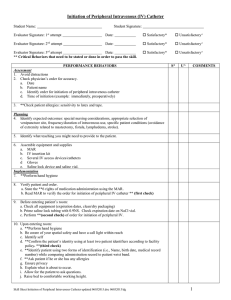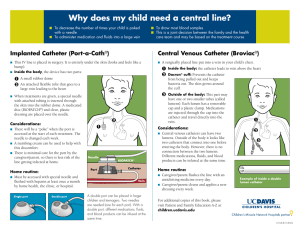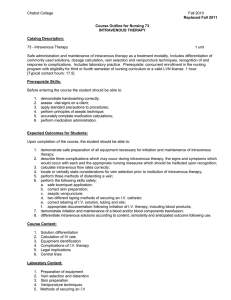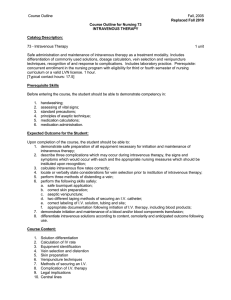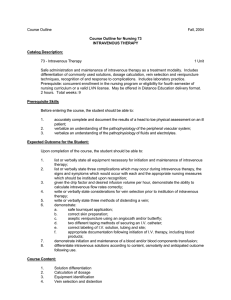Blood & IV Access Terminology: Reference Guide
advertisement
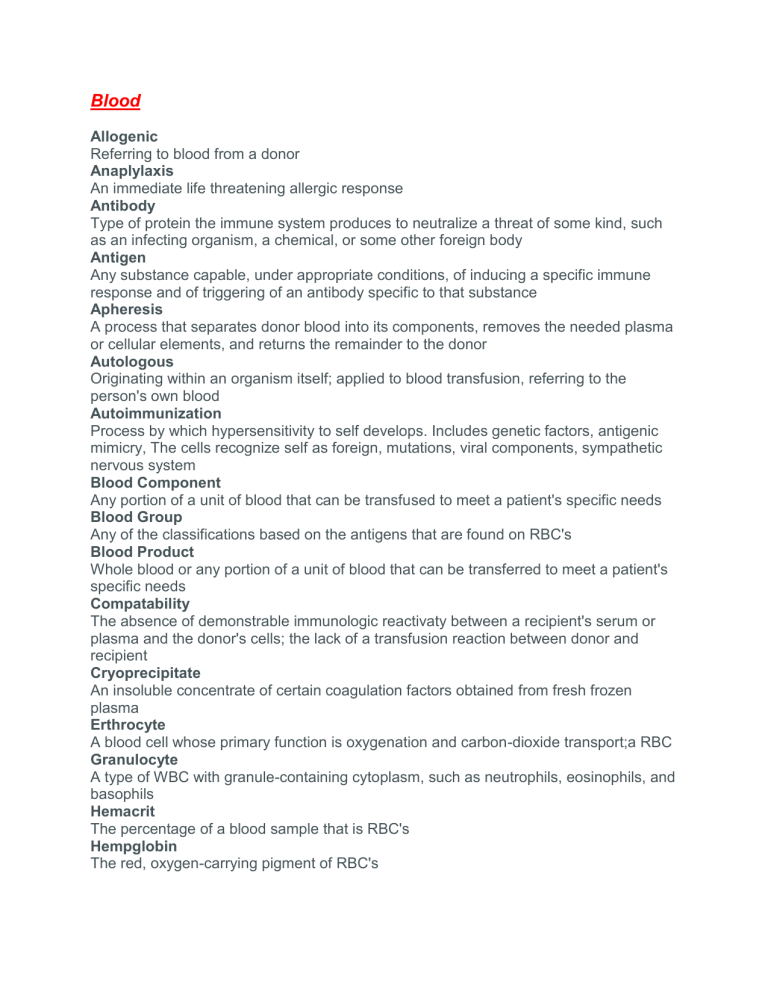
Blood Allogenic Referring to blood from a donor Anaplylaxis An immediate life threatening allergic response Antibody Type of protein the immune system produces to neutralize a threat of some kind, such as an infecting organism, a chemical, or some other foreign body Antigen Any substance capable, under appropriate conditions, of inducing a specific immune response and of triggering of an antibody specific to that substance Apheresis A process that separates donor blood into its components, removes the needed plasma or cellular elements, and returns the remainder to the donor Autologous Originating within an organism itself; applied to blood transfusion, referring to the person's own blood Autoimmunization Process by which hypersensitivity to self develops. Includes genetic factors, antigenic mimicry, The cells recognize self as foreign, mutations, viral components, sympathetic nervous system Blood Component Any portion of a unit of blood that can be transfused to meet a patient's specific needs Blood Group Any of the classifications based on the antigens that are found on RBC's Blood Product Whole blood or any portion of a unit of blood that can be transferred to meet a patient's specific needs Compatability The absence of demonstrable immunologic reactivaty between a recipient's serum or plasma and the donor's cells; the lack of a transfusion reaction between donor and recipient Cryoprecipitate An insoluble concentrate of certain coagulation factors obtained from fresh frozen plasma Erthrocyte A blood cell whose primary function is oxygenation and carbon-dioxide transport;a RBC Granulocyte A type of WBC with granule-containing cytoplasm, such as neutrophils, eosinophils, and basophils Hemacrit The percentage of a blood sample that is RBC's Hempglobin The red, oxygen-carrying pigment of RBC's Leukocyte A WBC Plasma The liquid portion of the blood in which the particulate components are suspended (including waste products delivered to kidneys and liver) Platelet A cellular component of blood that helps with clotting Refractory Resistant to treatment; applied to blood transfusion, referring to an immunologic response developed after frequent exposure to donor cells or serum, resulting in resistance to treatment Serum The clear, liquid portion of blood that remains after coagulation has taken place Thrombocytopenia Low platelet count Transfusion The introduction of whole blood or blood components directly into the blood stream IV Bevel the slanted surface at the tip of a needle Bifurcation division into two branches; fork Butterfly Needle a small, winged-tip needle used to initiate intravenous access Cannula a tube inserted into a vessel, duct, or cavity Catheter Hub the "handle" of an intravenous catheter, the part that allows access to the catheter's lumen for a variety of functions, such as the injection or infusion of fluids or drugs or the introduction of a guide wire Colonization implantation and growth of a micro-organism on or in a host Central Venous Catheter a blood-vessel access device usually inserted into the subclavian or jugular vein with the distal tip resting in the superior vena cava just above the right atrium; used for longterm intravenous therapy or parenteral nutrition Drip Chamber the portion of an intravenous administration set that lies just below the tubing insertion spike and allows visualization of the individual drops of solution being infused; the portion squeezed and released to begin the flow of solution immediately after insertion of the spike into the solution bag or bottle when preparing an intravenous infusion set Drip Factor or Drop Factor the calibration or number of drops per milliliter of solution delivered for a particular drip chamber Embolus a blood clot or a bolus of air developed in or introduced into a blood vessel that moves from its place of origin and is capable of obstructing blood circulation Flash Chamber the portion of an over-the-needle catheter that allows observation of a blood return when the catheter enters a vein Fluid-volume Deficit loss of both water and electrolytes from the extracellular fluid; also called hypovolemia Heparin Lock an intravenous catheter inserted into a vein and left in place for the intermittent administration of medication through its port or as an open line for emergency situations and intermittently flushed with a heparin solution to maintain patency Hypertonic referring to a solution that has a higher osmolarity than body fluids have Hypotonic referring to a solution that has a lower osmolarity than body fluids have Infiltration seepage or introduction of fluid, such as intravenous fluid, into the tissues surrounding a blood vessel; similar to extravasation Infusion slow, intentional introduction of fluid into a vein Infusion Pump device that delivers intravenous fluids via positive pressure at a specific preset rate Injection Cap a rubber cap attached to the end of an intervenous catheter or extension tubing to allow access to the blood vessel for injecting fluid Injection Port a small, covered, branched portion of intravenous tubing configured as a place to inject medication or fluid into the infusing solution Intravascular within a blood vessel Introducer Needle the needle inside an over-the-needle catheter used to pierce the wall of a vein to initiate intravenous access that is withdrawn and discarded after the catheter is properly positioned within the vein Isotonic referring to a solution that has the same osmolarity as body fluids Over-the-needle Catheter (ONC) a plastic catheter that fits over a needle and is used to pierce the wall of a vein to initiate intravenous access Patent open and unobstructed Percutaneous performed through the skin Peripherally Inserted Central Catheter (PICC) a catheter used for long-term intravenous access and inserted in the basilic or cephalic vein just above or below the antecubital space with the tip of the catheter resting in the superior vena cava Phlebitis inflammation of a vein Roller Clamp device with intravenous tubing threaded through it that acts as a valve when turned (rolled) to increase, decrease, or stop the flow of fluid through the tubing Saline Lock an intravenous catheter inserted into a vein and left in place for the intermittent administration of medication through its port or as an open line for emergency situations and intermittently flushed with normal saline solution to maintain patency Thrombosis the formation or presence of a stationary blood clot within a blood vessel Time Tape self-adhesive, coated tape used for labeling an intravenous infusion, for example, with the time it was started Transparent Dressing a protective covering often used over intravenous insertion sites to allow easy visualization of the site for signs of inflammation Vascular Access Device (VAD) an umbrella term that includes a variety of catheters, cannulas, and infusion ports that allow intermittent or continuous access to a blood vessel Venipuncture inserting a needle into a vein to withdraw blood samples or to establish ongoing access to a vein Viscosity resistance to flow; a physical property of a substance that varies with the friction of its component molecules as they slide past one another; refers to thickness of fluid such as blood

